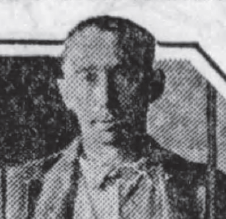 Lansing State Journal, April 1, 1927. When a girl’s body was found in a mineshaft near Coxton, Kentucky, in October 1925, the authorities claimed it was that of 14-year-old Mary Vickery, who had disappeared two months prior. In March 1926, Condy Dabney, a married father of two and former miner, who had forsaken that occupation to become a cab driver shortly before Vickery disappeared, was indicted for her murder. The charges stemmed from allegations made by another girl, Marie Jackson, who came forward six months after the crime, claiming to have been an eyewitness to the murder. The morning of the purported crime, Jackson said she and Vickery hailed Dabney’s cab. The three went to a restaurant and, a little later, to a secluded area where Dabney made sexual advances toward Vickery. When Vickery protested, Dabney struck her with a stick and she fell to the ground. Jackson tried to hide, but Dabney found her. He forced her to accompany him to the mine, where they dumped Vickery’s body. Jackson had not come forward earlier, she said, because Dabney threatened to burn her at the stake, or to have a friend do that, if she told anyone about the crime. The prosecution’s case was not strong. At Dabney’s trial, which occurred less than a month after his indictment, five witnesses substantially contradicted Jackson regarding the time of the alleged crime. Jackson claimed to have been with Vickery and Dabney from 7:00 a.m. until dark, but three friends of Vickery’s claimed to have been with her during the afternoon. The friends said a man named William Middleton had given them and Vickery a ride that afternoon, and their account was corroborated by the mother of two of the girls and by Middleton. The identification of the body also was dubious. It was too badly decomposed for anyone to identify it by appearance, and the defense insisted that the decomposition was too extensive for the body to be that of someone who had been dead only a little more than a month. A ring and stocking that the prosecution claimed had been found with the body were identified as Mary Vickery’s by her father, but his testimony was impeached because he did not attend the funeral. On cross examination, he acknowledged that, after viewing the body, he had not been “perfectly sure” it was his daughter’s. Moreover, although the father claimed the hair matched Mary Vickery’s hair, which was light, two other witnesses who had seen the body claimed the hair was dark. Exhumation could have resolved the issue, but that apparently was not suggested. To bolster the weak prosecution case, a jailhouse informant was called to the stand. His name was Claude Scott, and he was an acquaintance of Marie Jackson. Scott claimed that Dabney had offered him $15 to falsely testify that Jackson had admitted concocting the murder tale. It was not established whether the prosecution rewarded Scott for his testimony. Dabney took the stand in his own defense. He said he had no recollection of ever having had Mary Vickery in his cab, although Marie Jackson had been a customer on several occasions. Despite the conflicting evidence, the jury convicted Dabney on March 31, 1926, and the judge sentenced him to life at hard labor. Just a few days short of a year later, while Dabney’s appeal was pending, a police officer in Williamsburg, Kentucky, some 85 miles west of Coxton, happened to notice the name Mary Vickery on a hotel register. Because the name seemed familiar, he spoke with her, and soon learned that she was the person Dabney had been convicted of killing. She said she had run away the year before because she wasn’t getting along with her stepmother. Vickery said she did not even know Marie Jackson, who had supposedly concocted the story to collect a $500 reward posted by Mary Vickery’s father. Governor W.J. Fields pardoned Condy Dabney on March 22, 1927. Five days later, Jackson was convicted of perjury. The body from the mine apparently was never identified. - Rob Warden |